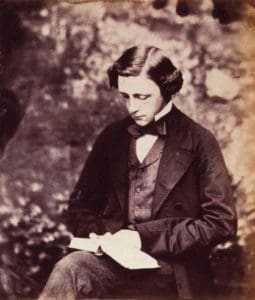
If you have ever read or watched one of the stories about “Alice in Wonderland,” then you know how much fun it is to enjoy the work of Lewis Carroll. This name is the pseudonym, or pen name, of 19th-century author Charles Lutwidge Dodgson. He used several pseudonyms in his lifetime, but he wrote his most famous poems and stories under the name Lewis Carroll.
When Carroll was growing up, he had a wild imagination and loved telling stories. His favorite hobbies as a boy were putting on puppet shows and magic shows for his siblings. Carroll also put together a family magazine of his poems and talked his family members into contributing other writings to it. When he got older, Carroll also became interested in math and photography, especially portraits of children. One of the children featured in his photographs was a little girl named Alice Liddell, who inspired the Alice in Wonderland stories.
Carroll’s poems were just as imaginative as his Alice stories. In fact, there are two very famous Carroll poems that are found within the Alice stories, as if the characters in Wonderland were composing and reciting them. These poems include “The Walrus and the Carpenter” and “Jabberwocky.” Carroll is also known for a long poem called “The Hunting of the Snark,” which was published in a different book.
“Jabberwocky” tells the story of a young man who fights a terrible creature called the Jabberwock. Try reading this poem out loud. Notice how Carroll used a lot of nonsense words. He left it up to the reader to decide exactly what each nonsense word might mean. Do you think that the sound of each nonsense word (such as “slithy”) helps you to understand the meaning?
Jabberwocky
‘Twas brillig, and the slithy toves
Did gyre and gimble in the wabe;
All mimsy were the borogoves,
And the mome raths outgrabe.“Beware the Jabberwock, my son
The jaws that bite, the claws that catch!
Beware the Jubjub bird, and shun
The frumious Bandersnatch!”He took his vorpal sword in hand;
Long time the manxome foe he sought—
So rested he by the Tumtum tree,
And stood awhile in thought.And, as in uffish thought he stood,
The Jabberwock, with eyes of flame,
Came whiffling through the tulgey wood,
And burbled as it came!One, two! One, two! And through and through
The vorpal blade went snicker-snack!
He left it dead, and with its head
He went galumphing back.“And hast thou slain the Jabberwock?
Come to my arms, my beamish boy!
O frabjous day! Callooh! Callay!”
He chortled in his joy.‘Twas brillig, and the slithy toves
Did gyre and gimble in the wabe;
All mimsy were the borogoves,
And the mome raths outgrabe.






